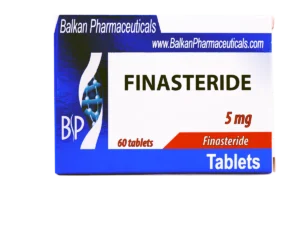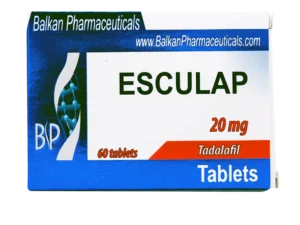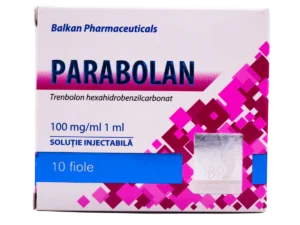International Common Name (ICN) of the active substance Finasteridum
COMPOSITION
1 tablet contains:
the active substance: finasteride 1 mg;
excipients: magnesium stearate, crospovidone (Kollidon®CL), ludipress® (lactose monohydrate, polyvidone, crospovidone).
PHARMACEUTICAL FORM
Tablets.
DESCRIPTION OF THE MEDICINAL PRODUCT
White or almost white, square-shaped tablets with a “BP” split and incrustation line on one side of the plate, and with the inscription “1” on the other side of the tablet, with tapering edges, the side surface with rounded edges.
THE PHARMACOTERAPEUTICAL GROUP and the ATC Code
Other dermatological preparations, ATC code: D11AX10.
-
-9% Out of stock
 Balkan Pharmaceuticals
Balkan Pharmaceuticals
PHARMACOLOGICAL PROPERTIES
Pharmacodynamic properties
Finasteride is a synthesized 4-azasteroid and chemically similar to testosterone and acts as a competitive and specific type 5 -reductase inhibitor type II, an intracellular enzyme that transforms testosterone into a more potent androgen, 5α- dihydrotestosterone (DHT). Finasteride causes a rapid decrease in serum DHT, reaching significant elimination in 24 hours of dosing.
Hair follicles contain 5-alpha-reductase type II. In men with male hair loss, the alopecia scalp contains small follicles and increased amounts of 5α-dihydrotestosterone (DHT). Men with gene deficiency of type II 5α-reductase do not suffer from male hair loss. Finasteride inhibits the process responsible for reducing the size of the scalp follicles, which can lead to the reversibility of the alopecia process.
Clinical trials in men with mild/moderate hair loss from vertex and/or frontal/central have demonstrated that: treatment with finasteride for 5 years reduced androgenic alopecia compared with both baseline and placebo no more than 3 months, and generated hair growth at 6 months (the shortest estimated duration); maximum efficacy was observed after a 2-year treatment. Therefore, finasteride stabilized hair loss compared to placebo in men with androgenetic alopecia. In addition, a placebo-controlled study over a 48-week period demonstrated that finasteride generated hair follicle transformation in an active hair growth phase.
A study in postmenopausal women with postmenopausal androgenetic alopecia indicated that finasteride is ineffective compared to placebo treatment over 12 months.
Pharmacokinetic properties
Bioavailability
The bioavailability after oral administration of finasteride is approximately 80% and is not affected by food. The maximum plasma concentration is obtained in about 2 hours after administration and absorption is complete after 6-8 hours.
Distribution:
It binds approximately 93% to plasma proteins. The volume of distribution is approximately 76 l (44-96 l).At steady state, the maximum plasma concentration at a dose of 1 mg / day was on average 9.2 ng / ml and was reached within 1-2 hours of dosing; AUC (0-24 hours) was 53 ng x h / ml.
Finasteride has been identified in cerebrospinal fluid (CSF), but the drug does not seem to be concentrated in the CSF. Also, a small amount of finasteride was detected in the seminal fluid of subjects treated with finasteride.
Metabolism:
Finasteride is metabolised primarily via the cytochrome P450 3A4 enzyme system. Following an oral dose of finasteride in males, two metabolites of finasteride have been identified that possess only a small portion of finasteride inhibitory activity on 5α-reductase.
Elimination:
After oral administration of a dose, approximately 39% (32-46%) of the dose was excreted in the urine as metabolites. Practically, no unchanged drug was excreted in the urine and 57% (51-64%) of the total dose was excreted via feces. Plasma clearance is approximately 165 ml / min (70-279 ml / min).
The rate of elimination of finasteride decreases with age.
The mean half-life of elimination half-life is 5-6 hours. It does not have clinical significance and does not involve a dose reduction in the elderly.
Hepatic impairment
The effect of hepatic insufficiency on the pharmacokinetics of finasteride has not been studied.
Kidney failure
In patients with chronic renal failure with creatinine clearance ranging from 9-55 ml/min, the area under the curve, maximum plasma concentration, half-life and protein binding of unconverted finasteride after a single dose were similar with those obtained in healthy patients.
THERAPEUTICAL INDICATIONS
1 mg tablet finasteride is indicated for the treatment of the early stage of hair loss (androgenetic alopecia) in men. Finasteride, tablets stabilize the process of androgenic alopecia in men aged 18-41 years. Its efficacy in bitemporal recession and in terminal hair loss phases was not determined. Finasteride is not indicated in women or children and adolescents.
DOSAGE AND METHOD OF ADMINISTRATION
Route of administration: Oral.
Men: 1 mg once a day with or without food for 3-6 months before any difference becomes apparent. There is no evidence that higher doses of finasteride have greater efficacy. The effectiveness and duration should always be assessed by your doctor. Generally, continuous treatment is required for 3-6 months before the hair loss process stabilizes. Continuous treatment is recommended to achieve the desired result. If treatment is discontinued, beneficial effects begin to disappear after 6 months and return to baseline after 9-12 months.
No data are available on the co-administration of Finasteride with local minoxidil for the treatment of hair loss in men.
Elderly patients.
No dose adjustment is required in elderly patients.
Patients with renal impairment.
No dose adjustment is required.
Patients with hepatic impairment.
There are no data on the use of finasteride in patients with liver failure.
Children.
Finasteride tablets are contraindicated in children.
SIDE EFFECTS
They rarely meet, usually they are poorly expressed and reversible. It is possible to decrease the potency and libido, reduce ejaculate volume, swelling and breast enlargement, rarely – hypersensitivity reactions (edema of the lips, rash). The frequency of sexual disturbances decreases during treatment.
The side effects listed below are classified by frequency, apparatus, system and organ. Frequency groups according to the MedDRA Convention are as follows: very common (≥1 / 10), common (≥ 1/100 and <1/10), uncommon (≥ 1/1000 and <1/100), rare (≥1 / 10000 and <1/1000) very rare (<1 / 10,000), not known (can’t be estimated from the available data).
Immune system disorders
Not known: hypersensitivity reactions, including rashes, pruritus, urticaria and edema of the lips and face.
Psychiatric disorders
Uncommon: low libido.
Cardiac disorders
Not known: palpitations.
Hepato-biliary disorders
Not known: increase in enzyme values liver.
Skin and subcutaneous tissue disorders
Uncommon: rash.
Not known: pruritus, urticaria.
Reproductive system and breast disorders
Uncommon: impotence, ejaculation disorders, decreased sperm count.
Not known: enlargement and tenderness of the breasts, testicular pain, infertility.
CONTRAINDICATIONS
Hypersensitivity to the components of the preparation.
Finasteride is contraindicated in women, children and adolescents.
It should not be used by men who already use Finasteride 5 mg tablets or any other 5-alpha reductase inhibitor for benign prostatic hypertrophy or any other indication.
OVERDOSE
In clinical trials, single doses of finasteride of up to 400 mg and repeated doses up to 80 mg daily for three months did not cause side effects. No specific treatment for Finasteride overdose is recommended.
WARNINGS AND SPECIAL PRECAUTIONS FOR USE
Finasteride should not be used in children/adolescents (<18 years). In clinical studies with Finasteride in men aged 18-41 years, the median plasma concentration of Prostate Specific Antigen (PSA) decreased from 0.7 ng/ml to 0.5 ng/ml in 12 months. This decrease in PSA concentrations should be considered, if during the treatment with Finasteride the patient requires a PSA test. In this case, the PSA value should be doubled before making any comparison with untreated patients.
Long-term data on fertility in humans are lacking and no specific studies have been conducted in men with oligospermia. Male patients planning to procreate a child were initially excluded from clinical trials.
Although animal studies have shown no relevant adverse effects on fertility, spontaneous cases of infertility and / or impaired quality of the semen have been reported after marketing. In some of these cases, patients also had other risk factors that could contribute to infertility. Discontinuation of finasteride treatment has been reported to normalize or improve the quality of semen. Male patients planning to procreate a child should consider discontinuing treatment.
The effect of hepatic insufficiency on the pharmacokinetics of finasteride has not been studied. This medicine contains lactose monohydrate. Patients with rare hereditary problems of galactose intolerance, lactose deficiency (Lapp) or syndrome glucose-galactose malabsorption should not take this medicine.
The period of pregnancy and breastfeeding.
It is contraindicated to women.
Crushed or broken finasteride tablets should not be handled by women who are or might be pregnant due to the possibility of absorption of finasteride and the subsequent development of abnormalities of the fetus’ external genitalia.
It is not known whether finasteride is excreted in human milk.
Effects on ability to drive and use machines
No data are available to demonstrate that it would affect the ability to drive or use machines.
INTERACTIONS WITH OTHER MEDICINES, OTHER TYPES OF INTERACTION
No clinically relevant interactions with other medicinal products have been identified. Primary metabolism of finasteride does not affect the cytochrome P450 system linked to the enzyme metabolism drug system.
The compounds that were tested in men included antipyrine, digoxin, glibenclamide, propranolol, theophylline and warfarin, and no interactions were detected.
In men with alopecia, due to the lack of data on concomitant use of finasteride and topical minoxidil, association is not recommended.
PRESENTATION, PACK
Tablet 1 mg.
Twenty (20) tablets in the blister. Three (3) blister packs together with instructions for administration in individual carton box.
STORAGE
Keep at temperatures below 25 °C.
Keep out of the reach and sight of children.
TERMS OF VALIDITY
Three (3) years.
Do not use after the expiry date stated on the pack.
LEGAL STATUS
With prescription.
CERTIFICATE OF REGISTRATION
SC Balkan Pharmaceuticals SRL N. Grădescu str., 4, MD-2002, or. Chisinau, Republic of Moldova.
The manufacturer
SC Balkan Pharmaceuticals SRL Industrial Street, 7 / A, MD-2091, or. Singera, Republic of Moldova.
This product you can buy here.







